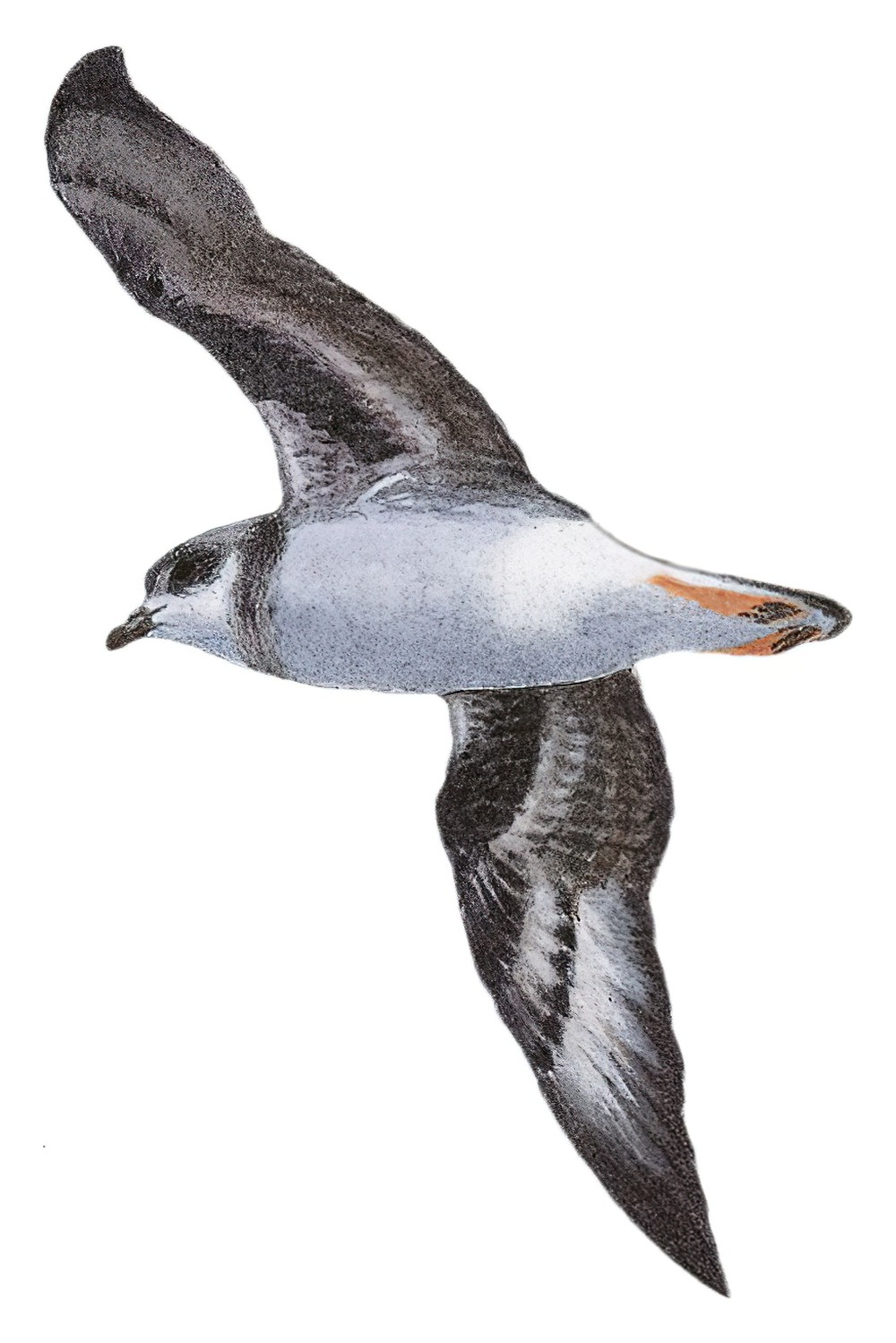Soft-plumaged Petrel / Pterodroma mollis

Soft-plumaged Petrel
SCI Name:
Protonym: Procellaria mollis Ann.Mag.Nat.Hist.(1), 13 p.363
Taxonomy: Procellariiformes / Procellariidae / Pterodroma
Taxonomy Code: soppet1
Type Locality: South Atlantic Ocean.
Author: Gould
Publish Year: 1844
IUCN Status: Least Concern
DEFINITIONS
PTERODROMA
(Procellariidae; Ϯ Great-winged Petrel P. macroptera) Gr. πτερον pteron wing; -δρομος -dromos -racer, -runner < τρεχω trekhō to run; the gadfly petrels were so named with reference to their fast weaving flight, as if pursued by horseflies; "1. FULMAREÆ. ... *4. Pterodroma, Bp. 14. fuliginosa, Banks. (grisea, Kuhl nec Gm. lugens? Soland. atlantica, Gould.) 15. macroptera, Smith. (brevirostris, Less.) 16. aterrima, Verr. (carbonaria? Solander.)" (Bonaparte 1856); "Pterodroma, Bp. (Thalassoica? p. Gr. - Procellaria, p. Hombr. et Jacq. - Ossifraga, p. Reich.) Rostrum brevissimum, curvum, valde compressum: cauda cuneata. Nigrae. Cum genere BULWERIA Procellariearum analogiam praebent. Parvulae inter congeneres conveniunt quippe statura cum gigantibus illis propriae sectionis. M. ant. pr. Afr. 3. 1. PROCELLARIA macroptera, Smith. ... 2. PROCELLARIA FULIGINOSA, Banks, nec Lath. ... *3. PROCELLARIA aterrima, Verr." (Bonaparte 1857); "Pterodroma Bonaparte, Comp. Rend. Acad. Sci. Paris, 42, 1856, p. 768. Type, by subsequent designation, Procellaria macroptera A. Smith (Coues, Proc. Acad. Nat. Sci. Phila., 1866, p. 137)." (Peters 1931, I, 60).
Var. Petrodroma, Pterodrome.
Synon. Aestrelata, Cookilaria, Hallstroma, Oestrelatella, Proaestrelata, Rhantistes.
mollis
L. mollis soft, tender.
SUBSPECIES
Soft-plumaged Petrel (mollis)
SCI Name: Pterodroma mollis mollis
mollis
L. mollis soft, tender.
Soft-plumaged Petrel (dubia)
SCI Name: Pterodroma mollis dubia
dubia
L. dubius doubtful, dubious < duo two; habere to have.
• "34. ÆTHOPYGA DUBIA, n. sp. ... The three examples on which this species is founded are difficult to distinguish, by their plumage alone, from Æ. bella ♀ vel ♂ juv.; but the dimensions are considerably greater ... Doubtless the adult male will closely resemble that of Æ. bella." (Tweeddale 1878) (syn. Aethopyga pulcherrima).
• ex “Soui-manga vert et gris” of Audebert & Vieillot 1802 (syn. Cyanomitra verticalis).
• "Eine vermutlich neue Bekassine aus Japan. ... Da mir der Vogel lange zweifelhaft war, und ich auf Grund des einen Exemplars seiner "Güte" als neue Art nicht sicher bin, so will ich ihn, für den Fall er sich bestätigen sollte, Gallinago dubia nennen." (Deichler 1897) (syn. Gallinago megala).
• ex “Soui-manga brun et blanc” of Audebert & Vieillot 1802 (syn. Leptocoma zeylonica).
• "GENUS XXXII. TURDUS. ... 4. T. dubius. T. nigro-cærulescens subtus albus, remigibus rectricibusque fuscis. Doubtful Thrush, Gen. Syn. Sup. ii. p. 182. 13. HABITAT in Nova Hollandia: longit. poll. 9.: —rostrum cærulescens: lingua apice setacea: corpus supra cæruleo-nigricans, subtus album: rectrices elongatæ: pedes fusci." (Latham 1802) (syn. Myiagra inquieta).
• "41.— CINNYRIS (?) DUBIA, sp. nov. ... I am in doubt whether this species may not prove to belong to the Meliphagidæ, coming between the genera Myzomela and Glyciphila." (Ramsay 1879) (syn. Myzomela melanocephala).
• "9. MYRMECOCICHLA DUBIA, sp. n. Adult. Allied to M. melanura (Temm.), but larger, and with the under tail-coverts brownish-black, edged with sandy buff instead of white, and the under wing-coverts dusky instead of whitish. Iris brown; bill dull orange-red; legs and feet orange-red." (Blundell & Lovat 1899) (Oenanthe).
• "122. PACHYCEPHALA BRUNNEA, Ramsay ‡ ... ‡ The specific term of brunnea having been previously adopted for another species of Pachycephala, that of dubia may be used for this species." (Ramsay 1879) (syn. Pachycephala griseiceps brunnescens).
• "39. Philentoma dubium sp. nov. Mr. Everett sent two males and two females of a Philentoma, all from Bunguran ... I have been doubtful indeed whether the Bunguran bird should form a distinct species or not; but the above stated differences are obvious and not to be overlooked, so I thought it best to give the form a name. As I hope to receive further material I will give in due time further information as to the constancy of the character of Philentoma dubium, which at present I have no reason to doubt, as they are clear enough in four specimens. Perhaps Ph. dubium may turn out to be of subspecific value." (Hartert 1894) (subsp. Philentoma pyrhoptera).
• "5. Amydrus? dubius, new species. ... A single specimen of this interesting bird was obtained by Dr. Abbott. It is referred with some doubt to Amydrus, since it differs from the known species of this genus in its small size, circular nostrils, and concealed (instead of exposed) rufous of the wings. It has been carefully compared with descriptions of related genera, but differs from the majority of them in having the wings longer than the tail. This last character is apparently all that separates it from Cabanis's Myiopsar [= Pœptera]." (Richmond 1897) (syn. Poeoptera kenricki).
• "PTERODROMA MOLLIS. SOFT-PLUMAGED PETREL. (PLATE 86.)* ... *The Plate is lettered Œstrelata mollis. ... The bird figured and described is the supposed Australian record." (Mathews 1912); "Pterodroma dubius, new name for the bird figured and described in my 'Birds of Australia,' vol. ii. pt. 2, pl. 86, p. 157, July 31st, 1912 North Australia." (Mathews 1924) (syn. Pterodroma mollis).
UPPERCASE: current genus
Uppercase first letter: generic synonym
● and ● See: generic homonyms
lowercase: species and subspecies
●: early names, variants, mispellings
‡: extinct
†: type species
Gr.: ancient Greek
L.: Latin
<: derived from
syn: synonym of
/: separates historical and modern geographic names
ex: based on
TL: type locality
OD: original diagnosis (genus) or original description (species)












